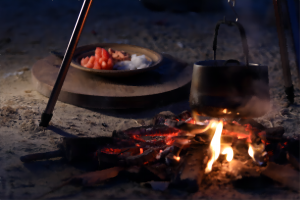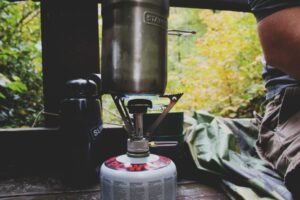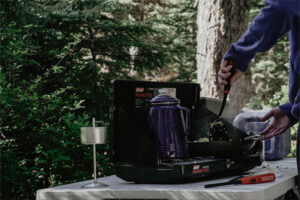 Camping is a great way to satisfy your need for adventure, excitement, and learning new things. But a fantastic camp is not always guaranteed by the weather. We have a solution: hot tents. Do not let the snow and rain ruin your trip. They will greatly improve the comfort level of camping. The idea behind a hot tent is to install a heating source inside, with a wood stove being the best option. You will be able to feel the warmth better. Whether it rains or snows outside, a heated tent comes in handy.
Camping is a great way to satisfy your need for adventure, excitement, and learning new things. But a fantastic camp is not always guaranteed by the weather. We have a solution: hot tents. Do not let the snow and rain ruin your trip. They will greatly improve the comfort level of camping. The idea behind a hot tent is to install a heating source inside, with a wood stove being the best option. You will be able to feel the warmth better. Whether it rains or snows outside, a heated tent comes in handy.
Hot Tents For Winter Camping Gear
Always bring appropriate sleeping gear for the weather in which you plan to sleep. If something happens and you can not start a fire, you are out of luck and will be freezing cold, if not worse.
- Hot tent with stove, jack, and pipe
- Comfortable sleeping bag
- Sleeping pad with a high R-value
- Non-sweat layered Clothing
- Food and utensils for possible survival
Hot tent with a stove, jack, and pipe
Wood should be added to hot tent stoves every 90 minutes, or every 4 hours if you are lucky enough to have a good quality stove. They do not last all night, and unless you are in a group taking turns, a wood stove for hot tenting is usually used for cooking, warming up before bed, and drying clothes. It is not intended to keep you warm while sleeping, and your sleeping bag/kit should be designed as if you did not have the stove.
A jack is crucial to remember when using a stove to generate heat. It will assist you in properly installing the heating source.
A heat-resistant pipe is needed for a proper smoke exit from your tent. You will need a jack to install it correctly inside.
Wood Treat the wood correctly if you are starting from scratch. Untreated wood is not easy to handle. When using a stove inside your tent, always burn hardwood. It will produce fewer sparks and embers and burn hotter and longer. If you must use softwood, dampen down your stove so that the fire burns more slowly. Your tent will still get hot, but it will be much safer.
When the wood is burning inside the stove, do not stir it; this will create a lot of embers and is very dangerous.
Comfortable Sleeping Bag
It is highly recommended that you first get a decent sleeping bag and pad setup before entering the world of hot tents.
To be sure you are prepared for every temperature, it can be quite helpful to buy a sleeping bag that is 10 to 15 degrees lower than the temperature you anticipate experiencing. To further prevent further loss of body heat, a quality sleeping bag liner can help wick away sweat.
However, amateur campers frequently make the mistake of assuming that their sleeping bag’s rating will accurately indicate how cold-tolerant it is. First and foremost, you ought to learn more about the temperature rating of your sleeping bag.
Sleeping Pad with a High R-Value
When it comes to making friends with the floor of your tent, a sleeping pad truly makes all the difference. They not only improve comfort, but they also provide much-needed insulation to prevent the cold ground from stealing your heat. Particularly for pads with a high R-value, this is accurate.
The degree of insulation and heat transfer in camping gear is indicated by the R-value unit of measurement. The greater the R-value of a sleeping pad, the more it insulates and retains heat from your body, reducing the likelihood that it will lose heat to the floor.
For cold-weather camping, an R-value of 2-3 is generally required.
Non-Sweat Layered Clothing
Wearing clothing that is appropriate for the weather is another strategy to stay warm. This is crucial before bed since you will be losing heat as you sleep. Therefore, layering your clothing would be the wisest move. You should follow the layered clothing rule:
Innermost layer
Wool fleece or a synthetic material (merino wool) is required for this. Its function is to draw moisture away from your body to prevent perspiration and subsequent coldness. Cotton base layers absorb moisture like sponges, so never wear them.
Middle Layer
This layer serves as your insulation. Huge and fluffy is what it should be. In mild weather, fleece hoodies are a great option. You should wear a thick wool sweater or a puffy jacket when it is extremely cold outside. You might want two mid-layers when it is extremely cold outside. Additionally, you will need fleece pants or a similar mid-layer for your legs. Layering apply your pajamas too!
Outer Layer
Your shell layer is what keeps the rain out of your body. Additionally, it makes sure that the wind does not carry the heat from your mid-layer away. It should include waterproof and breathable clothing (rain jackets and pants).
To further protect yourself, you could bring additional layers, such as a hat, scarf, or neck gaiter. Layers allow you to add and remove them as needed to create a look and feel that suits you best.
How Cold Can You Camp in a Tent?
Up until it is time to tuck into your sleeping bag, campfires are a great way to stay warm.
When deciding whether it is too cold to camp in a tent, there are a lot of variables to take into consideration. Whether or not you have the necessary equipment and camping experience is a major factor.
Lower than 5°C (41°F) would be too cold for you if you are a novice and are using simple amateur equipment. 10-22°C (50°F to 65°F) would be ideal for tent camping for someone who has never done it before. You can camp at practically any temperature if you have the proper equipment and are prepared.
Even at 12 degrees Celsius (53 degrees Fahrenheit), which is on the chilly side, you can go camping! You can camp comfortably at 12 degrees Celsius as long as you have the necessary equipment and supplies to stay warm and well-fueled.
People Also Ask
Can you heat a tent with a candle?
Candles can be used to heat a tent, but we strongly advise against doing so. Tent, sleeping bag, and sleeping pad materials that are somewhat combustible when near an open flame in a confined space Undoubtedly, that presents a grade-A fire hazard.
When heating a tent, it is better to use an insulated tent, a down sleeping bag, or a tent heater to stay warm.
Is it warmer to sleep in a car than in a tent?
It is not always warmer to camp in a car than in a tent. A car can shield you from the wind chill and have more space than a tent. Car components and materials, however, tend to lower interior temperatures, so sleeping in a car might be more appropriate in warmer climates. However, because of their smaller volume, tents heat up more quickly and are suitable for cold weather but are more prone to drafts.





